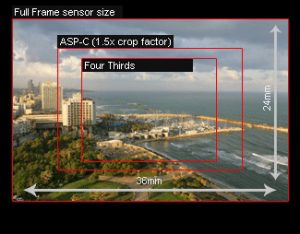Camera image sensor size and technology explained
Camera sensors come in different rectangular shapes and sizes. The sensor size will dictate whether it will capture a larger field of view as illustrated below.

Sensor size is important in photography because it also has an impact upon image quality. If you have two cameras with the same pixel count, but one has a physically larger sensor than the other, the one with the larger sensor will usually produce better quality images.
This is because the photo receptors, which are commonly called pixels these days, are larger on the bigger sensor.
The main purpose of a photo receptor is to receive light and generate an electrical signal that is converted into a digital image signal. The more light that the sensor receives, the stronger the image signal will be.
A strong signal requires less amplification and this means there’s less opportunity for image noise to introduced or enhanced.
A camera’s sensor is usually its most expensive component and this means cameras with larger sensors tend to be significantly more expensive than cameras with smaller sensors.
The camera’s body also usually needs to be made larger to house the bigger sensor and to accommodate the lenses that are required to produce the larger image circle.
To summarise, in general terms, cameras with larger sensors tend to be bigger and more expensive than those with smaller sensors and they produce better quality images.
Bigger camera sensor or fewer pixels?
As already mentioned, having a larger camera sensor allows the pixels to be made bigger and this has positive implications for image quality with noise levels being reduced and dynamic range extended. A similar thing can be achieved by keeping the pixel count down on a smaller sensor.
However, high pixel counts are often seen as a good thing because images are larger and it enables more detail to be recorded.
The challenge for manufacturers is to keep noise levels down and maintain image quality at the higher sensitivity settings when light levels are low.
Full Frame Advantages – Generally, a full frame sensor can provide a broader dynamic range and better low light/high ISO performance yielding a higher quality image than a crop sensor. Full frame sensors are also preferred when it comes to architectural photography due to having a wider angle which is useful with tilt/shift lenses.
Finally, a full frame DSLR will have a shallower depth of field than a crop sensor DSLR, which can be a beneficial aesthetic. When shooting at the same EFFECTIVE focal length, using the same aperture settings and shooting from the exact same angle/distance to the subject, the full frame camera will have a shallower depth of field (more bokeh) than the crop sensor camera.
This is because the larger the sensor, the longer the focal length of the lens needs to be to capture the same field of view. For example, a full frame sensor Canon 5D Mark III using a Canon 50mm f/1.4 lens gives the equivalent focal length or field of view as using a 31mm lens on a APS – C sensor Canon 7D since it has a 1.6 crop multiplier (31mm x 1.6 = 50mm). Now a 31mm lens doesn’t exist of course, but you get the idea. The larger the sensor, the longer the focal length required in order to create the same field of view to match the crop sensor, hence a shallower depth of field is created due to the additional focal length.
Crop Sensor Advantages – Whilst a crop sensor DSLR doesn’t provide the same level of image quality as a full frame DSLR, it does offers major advantages when it comes to cost. It can also be very effective for telephoto photography by providing the extra reach gained from the crop sensor multiplier. For example, this can be very useful when shooting sports, wildlife, and other types of photojournalism. Just imagine that on a Canon crop frame body such as a Canon 7D; your Canon 70-200mm f/2.8 lens is effectively a 112-320mm lens!
Let me also clarify that this is simply a benefit, it doesn’t mean that you SHOULD use a crop sensor DSLR when shooting these types of photography. This is going to depend on your intended use, budget, and so forth. For those on a budget (which I think is probably most of us), the additional focal length and low cost of the crop sensor DSLR are great advantages. A professional will still get the best overall quality by having a full frame DSLR paired with a suitable longer telephoto lens.
I hope this helps clarify the difference and benefits of Crop vs Full frame sensors. If you have any further questions or want some advice please feel free to speak to me directly.
Adrian Hedges
March 2017